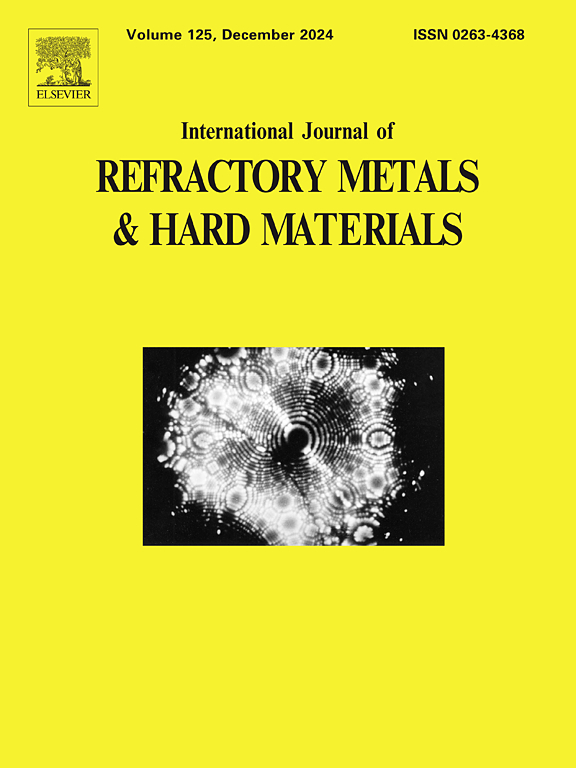无压烧结原位制造合成的 W-HfC 合金的微观结构和力学性能
IF 4.6
2区 材料科学
Q2 MATERIALS SCIENCE, MULTIDISCIPLINARY
International Journal of Refractory Metals & Hard Materials
Pub Date : 2024-11-26
DOI:10.1016/j.ijrmhm.2024.106978
引用次数: 0
摘要
制造过程中主要使用的材料会对 W-HfC 合金的微观结构和机械性能产生重大影响。本研究将不同的初始成分(如 HfH2/WC、HfH2/C 和 HfC)分别混合到 W 粉末中,采用原位反应烧结法制备了三类 W-HfC 合金(分别简称为 WHC1、WHC2 和 WHC3)。通过 X 射线衍射、电子显微镜和高温拉伸试验对三种合金的微观结构和机械性能进行了比较研究。结果表明,WHC2 合金的韧性-脆性转变温度为 300 ℃,综合性能最佳。300 ℃拉伸试验表明,WHC2 合金呈现出完整的塑性断裂曲线,抗拉强度为 400 MPa,残余变形为 9%,塑性增强。这主要归因于第二相颗粒在晶界和 W 基体晶粒内的分散强化效应。此外,WHC2 合金优异的综合性能表明,原位反应可显著降低烧结难度,而由此产生的第二相颗粒在改善 W 基合金性能方面具有相当大的优势。这些发现为 W-HfC 合金的合成过程和机械性能提供了宝贵的见解,从而推动了它们在高温环境中的应用。本文章由计算机程序翻译,如有差异,请以英文原文为准。
Microstructure and mechanical properties of W-HfC alloy synthesized by in-situ fabrication via pressureless sintering
The materials, primarily utilized in the manufacturing process, significantly impact the microstructure and mechanical properties of W-HfC alloys. In this study, different initial composition, such as HfH2/WC, HfH2/C and HfC, were respectively mixed into W powders, three categories of W-HfC alloys (abbreviated as WHC1, WHC2 and WHC3 successively) were fabricated by in-situ reaction sintering methods. The microstructure and mechanical properties of three alloys were investigated comparatively by using X-ray diffraction, electron microscopy and high temperature tensile tests. The results revealed that WHC2 alloy presents an exceptional ductile-brittle transition temperature of ∼300 °C and the best comprehensive performance. Tensile testing at 300 °C indicates that WHC2 alloy exhibits a complete plastic fracture curve with a tensile strength of 400 MPa and a residual deformation of 9 %, as well as the plasticity enhancement. It is mainly attributable to the dispersion strengthening effect of second phase particles at grain boundaries and within W-matrix grains. Furthermore, the excellent overall performance of the WHC2 alloy demonstrates that the in-situ reaction can significantly reduce sintering difficulties, while the resultant second phase particles provide considerable advantages in improving the properties of W-based alloys. These findings provide valuable insights into the synthesis process and mechanical performance of W-HfC alloys, enabling advancements in their application in high-temperature environments.
求助全文
通过发布文献求助,成功后即可免费获取论文全文。
去求助
来源期刊
CiteScore
7.00
自引率
13.90%
发文量
236
审稿时长
35 days
期刊介绍:
The International Journal of Refractory Metals and Hard Materials (IJRMHM) publishes original research articles concerned with all aspects of refractory metals and hard materials. Refractory metals are defined as metals with melting points higher than 1800 °C. These are tungsten, molybdenum, chromium, tantalum, niobium, hafnium, and rhenium, as well as many compounds and alloys based thereupon. Hard materials that are included in the scope of this journal are defined as materials with hardness values higher than 1000 kg/mm2, primarily intended for applications as manufacturing tools or wear resistant components in mechanical systems. Thus they encompass carbides, nitrides and borides of metals, and related compounds. A special focus of this journal is put on the family of hardmetals, which is also known as cemented tungsten carbide, and cermets which are based on titanium carbide and carbonitrides with or without a metal binder. Ceramics and superhard materials including diamond and cubic boron nitride may also be accepted provided the subject material is presented as hard materials as defined above.

 求助内容:
求助内容: 应助结果提醒方式:
应助结果提醒方式:


